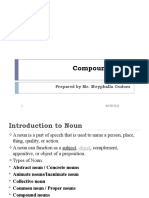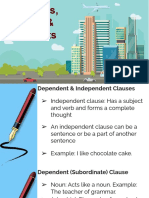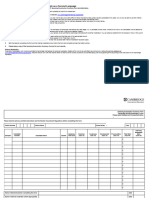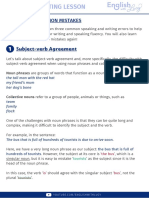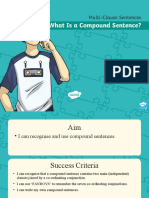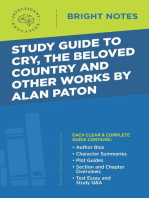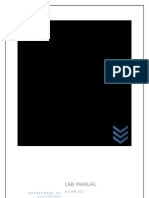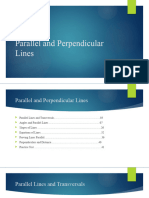An Introduction To Simple Compound and Complex Sentences
Uploaded by
Prakash KaloAn Introduction To Simple Compound and Complex Sentences
Uploaded by
Prakash KaloAn Introduction to Simple,
Compound, and Complex
Sentences
Fifth Grade Writing
by Sarah Sumnicht November 11, 2018
Introduce your students to three sentence structures. In this exercise, students will participate in a reading
scavenger hunt as they look for different types of sentences in a short story.
Learning Objectives
Students will be able to differentiate between three different sentence structures.
Materials and preparation Key terms
Class set of Main Character (text only) simple sentence
Online access to the digital exercise Types of compound sentence
Sentences complex sentence
One piece of chart paper dependent clause
Colored pencils for students (red, yellow, and subordinate conjunction
blue)
Personal whiteboards for students (or
notebooks)
Document camera
Computer or tablet
Class set of Is Something Missing? (optional)
Class set of Find the Sentence Patterns
(optional)
Class set of Mix It Up! Making Varied Sentences
(optional)
Class set of Sentence Makeover 1 (optional)
Attachments
PDF
Reading for Comprehension: Jason and the Game Show
PDF
What Are the Two Main Parts of a Sentence?
PDF
Find the Sentence Patterns
PDF
Mix It Up! Making Varied Sentences
PDF
Sentence Makeover 1
PDF
Reading for Comprehension: Jason and the Game Show
Get more lesson plans at https://www.education.com/lesson-plans/
Introduction (5 minutes)
Display a piece of chart paper and divide it into three equal horizontal sections or rows. (Note: this chart
can be prepared before the lesson.)
In the top section, write a simple sentence and read it aloud (i.e., "The smart kids read books every
night.").
In the second section, write a compound sentence and read it aloud. (i.e., "The kids read books every
night and then they go to bed.")
In the bottom section, write a complex sentence and read it aloud (i.e., "The kids read books at night
before going to bed.").
Explain that each of these sentences gives similar information, but they are structured differently.
Tell students that today they will be learning about three sentence structures.
Explicit Instruction/Teacher modeling (10 minutes)
Refer to the first example and explain that this sentence is called a simple sentence because it has one
complete thought. Simple sentences have a subject and a predicate (verb phrase) and can contain
description words.
Label the first section on the chart "simple sentence" and provide another example like, "Dogs and cats
make great pets."
Point to the second section on the chart and tell students that this is called a compound sentence
because it has two complete thoughts that are combined by a conjunction. Remind students that
conjunctions are joining words like "and," "but," or "so" (circle the conjunction in the sentence).
Compound sentences have two verbs (underline the two verbs in the sentence).
Label the second section on the chart "compound sentence" and provide another example like, "I love
elephants, but I don't like the zoo."
Refer to the third section on the chart and explain that this is called a complex sentence because it has
one complete thought and a dependent clause, which is a descriptive phrase that cannot stand alone. A
complex sentence always has a subordinate conjunction like "although," "before," "because," or "if"
(circle the subordinate conjunction). Sometimes the independent clause and dependent clause are
separated by a comma.
Label the third section on the chart "complex sentence" and provide another example like, "After dinner,
we can watch a movie."
Guided Practice (10 minutes)
Write a sentence on the board that reads, "I am allergic to milk, so I can't have ice cream."
Instruct students to turn to an elbow partner to determine what type of sentence it is (answer:
compound).
Call on a student to tell what type of sentence it is and how they know (answer: it contains a conjunction
and two complete thoughts)
Repeat with several sentences:
"I always ride the roller coaster at the amusement park." (simple)
"We ran downstairs and went outside." (compound)
"If she's done with her homework, she can play." (complex)
"They went swimming yesterday." (simple)
"He's bringing chips even though the party is over." (complex)
Independent working time (10 minutes)
Hand out the short story "Jason and the Gameshow" on the Main Character worksheet. (Note: students
will only need the text for this exercise. You may choose to cut off the questions and title before making
copies.)
Instruct students to read the text and find at least one example of each type of sentence.
Tell students that they should underline a simple sentence in red, a compound sentence in yellow, and a
complex sentence in blue. Write these instructions on the board for student reference.
Circulate and offer support as needed.
Get more lesson plans at https://www.education.com/lesson-plans/
Related books and/or media
SONG: "The Hustle"
Differentiation
Support:
Review subjects and predicates so that your students are familiar with the basic parts of a sentence (see
resources).
Provide additional practice with identifying sentences in a text (see optional materials).
Enrichment:
Ask students to combine simple sentences to improve a piece of writing (see optional materials).
Have students practice writing different types of sentences (see related media).
Assessment (10 minutes)
Use a projector to show the digital exercise Types of Sentences.
Read the first sentence aloud as students follow along.
Instruct students to identify which type of sentence it is and write their answer on a personal whiteboard.
Tell students to hold up their answers. Scan student responses to gauge understanding.
Call on a student to read their answer aloud before moving on to the next sentence in the exercise.
Review and closing (5 minutes)
Do the "high-five hustle" to review the lesson:
Ask students to stand up, raise their hands and high five a peer. This will be their short-term hustle
buddy.
When everybody has a partner, tell students to come up with a simple sentence about pizza and
tell their hustle buddy. Make sure both buddies have a turn.
Solicit answers from a few students.
Then ring a chime or play a song, like "The Hustle," as a signal for them to raise their hands and
high five a different partner for the next question.
Continue doing the hustle and asking students to come up with complex and compound sentences
about various subjects (i.e., the sun, elephants, lunch).
Get more lesson plans at https://www.education.com/lesson-plans/
You might also like
- Compound Subjects, Predicates and Parallel StructuresNo ratings yetCompound Subjects, Predicates and Parallel Structures3 pages
- Sentence - Structure - Types G6.ppt Version 1No ratings yetSentence - Structure - Types G6.ppt Version 135 pages
- Iii. The Predicate: Classification (According To The Structure and Meaning of The Predicate)100% (1)Iii. The Predicate: Classification (According To The Structure and Meaning of The Predicate)7 pages
- Expanding Sentences Through Verb Modification - PPTX Filename UTF-8''ExpandNo ratings yetExpanding Sentences Through Verb Modification - PPTX Filename UTF-8''Expand11 pages
- Compound Noun: Prepared by Mr. Meyphalla OudomNo ratings yetCompound Noun: Prepared by Mr. Meyphalla Oudom8 pages
- How To Learn A Foreign Language Effectively: Sample Essay AnalysisNo ratings yetHow To Learn A Foreign Language Effectively: Sample Essay Analysis1 page
- 751 Passive Vs Active Voice Present MCQ Grammar Quiz Test Exercise100% (1)751 Passive Vs Active Voice Present MCQ Grammar Quiz Test Exercise3 pages
- Topic: Kinds of Sentences & Clauses: EnglishNo ratings yetTopic: Kinds of Sentences & Clauses: English4 pages
- Subject-Verb Agreement: Avoid These Common Mistakes100% (1)Subject-Verb Agreement: Avoid These Common Mistakes9 pages
- Sentences Compound, Complex, Compound-Complex.No ratings yetSentences Compound, Complex, Compound-Complex.10 pages
- Preston Lee’s 2-in-1 Book Series! Beginner English & Conversation English Lesson 1: 20 For Korean SpeakersFrom EverandPreston Lee’s 2-in-1 Book Series! Beginner English & Conversation English Lesson 1: 20 For Korean SpeakersNo ratings yet
- Study Guide to Cry, The Beloved Country and Other Works by Alan PatonFrom EverandStudy Guide to Cry, The Beloved Country and Other Works by Alan PatonNo ratings yet
- Preston Lee’s 2-in-1 Book Series! Beginner English & Conversation English Lesson 1: 20 For Portuguese SpeakersFrom EverandPreston Lee’s 2-in-1 Book Series! Beginner English & Conversation English Lesson 1: 20 For Portuguese SpeakersNo ratings yet
- English Grammar Practice - The Noun: Explanations & Exercises with AnswersFrom EverandEnglish Grammar Practice - The Noun: Explanations & Exercises with AnswersNo ratings yet
- LESSON PLAN Clasa 7-A A Baranga Triba IuliaNo ratings yetLESSON PLAN Clasa 7-A A Baranga Triba Iulia5 pages
- Class Schedule in Esp: Regular Time Slot Time Slot in The New Normal SituationNo ratings yetClass Schedule in Esp: Regular Time Slot Time Slot in The New Normal Situation5 pages
- Developing, Deploying, and Monitoring in The CloudNo ratings yetDeveloping, Deploying, and Monitoring in The Cloud19 pages
- Ambikapathi-Amaravathi and Romeo-Juliet: A Comparative StudyNo ratings yetAmbikapathi-Amaravathi and Romeo-Juliet: A Comparative Study12 pages
- Past Simple Reg Irreg Verbs Grammar Exercises 1c2ba Eso Curso 2013 14No ratings yetPast Simple Reg Irreg Verbs Grammar Exercises 1c2ba Eso Curso 2013 1413 pages
- Lahore University of Management Sciences REL312/PHIL344 Logic and Rhetoric in The Qur'anNo ratings yetLahore University of Management Sciences REL312/PHIL344 Logic and Rhetoric in The Qur'an103 pages
- Addendum a- Answer Sheet Grade 8 November Exam CA FinalNo ratings yetAddendum a- Answer Sheet Grade 8 November Exam CA Final2 pages
































